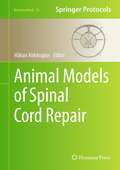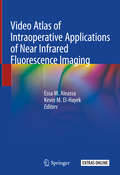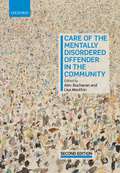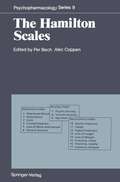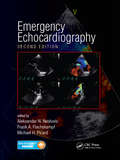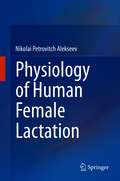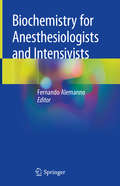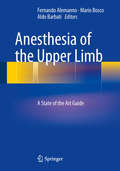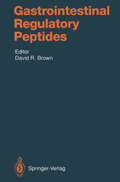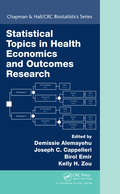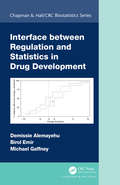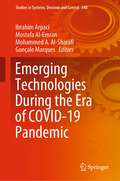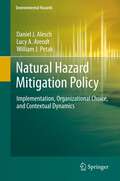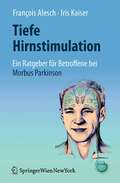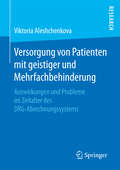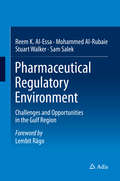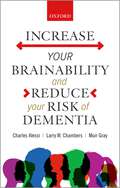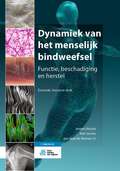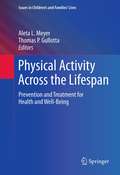- Table View
- List View
Animal Models of Spinal Cord Repair (Neuromethods #76)
by Håkan AldskogiusThe development of treatment strategies that can help patients with spinal cord injury to regain lost functions and an improved quality of life is a major medical challenge, and experimental spinal cord research has to meet these challenges by resolving fundamental problems, establishing a basis for possible novel treatment strategies of spinal cord injury, and motivating their clinical translation. In Animal Models of Spinal Cord Repair, expert researchers examine a broad range of experimental models for research on spinal cord injury, how they have contributed to our current state of knowledge, and what their advantages are in the further advancement of spinal cord repair. With models from simple lamprey to non-human primates, the information presented is intended to guide the implementation of animal models for spinal cord repair as well as to raise the awareness of the relevance of experimental models which may not be in the current mainstream of this research. As a part of the Neuromethods series, this work contains the kind of detailed description and implementation advice to guarantee successful results in the laboratory. Comprehensive and cutting-edge, Animal Models of Spinal Cord Repair presents the background information and hands-on methods descriptions, as well as the basic and clinical issues, needed to stimulate and guide researchers with different backgrounds towards the development of improved strategies for functionally relevant repair of the injured human spinal cord.
Animal Welfare in a Changing World
by Rebecca Aldworth Shelley M. Alexander Regina Asmutis-Silvia Panayiotis Panos Azmanis Prof Daniel Berckmans Lotta Berg Harry Blokhuis Xavier Boivin John Bradshaw Prof. Victoria Braithwaite Stijn Bruers Henry Buller Dr Andrew Butterworth Joyce D’Silva Sarah Dolman Chris Draper David Fennell Dr Charles Foster Taryn Glass Temple Grandin Adam Hart Dr Sophia Hepple Kristof Hermans Elly Hiby Dr Miel Hostens Mark Jones Michael J Kuba Philip Lymbery Miriam Martin Tomas Norton Geert Opsomer Maria Panagiotopoulou Paul C. Paquet Conor Ryan Mark Simmonds Kalliopi Stara Rigas Tsiakiris Dr Bonny Ranst Paul Whittington Dr James W YeatesContemporary and challenging, this thought-provoking book outlines a number of the key dilemmas in animal welfare for today's, and tomorrow's, world. The issues discussed range from the welfare of hunted animals, to debates around intensive farming versus sustainability, and the effects of climate and environmental change. The book explores the effects of fences on wild animals and human impacts on carrion animals; the impacts of tourism on animal welfare; philosophical questions about speciesism; and the quality and quantity of animal lives. The welfare impacts of human-animal interactions are explored, including human impacts on marine mammals, fish, wildlife, and companion and farm animals. Animal Welfare in a Changing World provides: Concise, opinion-based views on important issues in animal welfare by world experts and key opinion leaders. Pieces based on experience, which balance evidence-based approaches and the welfare impacts of direct engagement through training, campaigning and education. A wide-ranging collection of examples and descriptions of animal welfare topics which outline dilemmas in the real world, that are sometimes challenging, and not always comfortable reading. This is a 'must-read' book for animal and veterinary scientists, ethologists, policy and opinion leaders, NGOs, conservation biologists and anyone who feels passionately about the welfare of animals
Systems Biology: Integrative Biology and Simulation Tools
by Aleš Prokop and Béla CsukásGrowth in the pharmaceutical market has slowed down – almost to a standstill. One reason is that governments and other payers are cutting costs in a faltering world economy. But a more fundamental problem is the failure of major companies to discover, develop and market new drugs. Major drugs losing patent protection or being withdrawn from the market are simply not being replaced by new therapies – the pharmaceutical market model is no longer functioning effectively and most pharmaceutical companies are failing to produce the innovation needed for success. This multi-authored new book looks at a vital strategy which can bring innovation to a market in need of new ideas and new products: Systems Biology (SB). Modeling is a significant task of systems biology. SB aims to develop and use efficient algorithms, data structures, visualization and communication tools to orchestrate the integration of large quantities of biological data with the goal of computer modeling. It involves the use of computer simulations of biological systems, such as the networks of metabolites comprise signal transduction pathways and gene regulatory networks to both analyze and visualize the complex connections of these cellular processes. SB involves a series of operational protocols used for performing research, namely a cycle composed of theoretical, analytic or computational modeling to propose specific testable hypotheses about a biological system, experimental validation, and then using the newly acquired quantitative description of cells or cell processes to refine the computational model or theory.
Video Atlas of Intraoperative Applications of Near Infrared Fluorescence Imaging
by Essa M. Aleassa Kevin M. El-HayekThis book represents a head-to-toe guide for clinicians who are interested in applying real-time near infrared (NIR) imaging for their patients. Expert surgeons from around the globe share their experience with NIR imaging, most commonly performed using indocyanine green (ICG) fluorescence. The chapters are structured to include a brief background, indications for use, followed by a technical description of the procedure. Each chapter is also accompanied by video examples and detailed information about necessary equipment, drug dosing, and alternative techniques. A pitfalls section serves as a “lessons learned” segment to bookend each chapter. Authors represent a comprehensive list of surgical subspecialties ranging from neurosurgery to plastic surgery.While it is not meant to serve as an exhaustive summary of ICG use in surgery, the goal is to highlight the successful use of this technology in a number of settings. As the technology and applications continue to expand, Video Atlas of Intraoperative Applications of Near Infrared Fluorescence Imaging serves as a foundation upon which to build.
Care of the Mentally Disordered Offender in the Community
by Alec Buchanan and Lisa WoottonThis revised and updated edition of Care of the Mentally Disordered Offender in the Community provides a comprehensive, evidence-based guide to theory and practice. The social and clinical context within which mental health care is provided to offenders in community settings has changed significantly in recent years. An increasing proportion of all mental health care is provided in the community and our knowledge of the links between violence and mental illness has advanced. Existing psychological and pharmacological treatments have been refined and new treatments have been introduced. Epidemiological and intervention-based research has evaluated these changes and suggested new avenues for clinical development. Over three sections, the second edition of Care of the Mentally Disordered Offender in the Community explores the key areas of the field. Part 1 describes the social, administrative and clinical context within which care is now given. Part 2 discusses treatment and the evaluation of violence risk when determining the most appropriate treatment. Part 3 explores psychiatric services and their relationship with other agencies. The text has been updated to cover recent developments in theory and practice. New chapters have been added that cover US provision for people with mental disorders leaving prison, the community management of sexual offenders, the relationship between care and coercion and the treatment of personality disorders. Written by a global team of experts, the book provides critical insights into the social, clinical, and institutional aspects of an increasingly important part of psychiatric community care.
The Hamilton Scales (Psychopharmacology Series #9)
by AlecCoppen PerBechThe European College of Neuropsychopharmacology (ECNP) is a scientific and educational association which represents a variety of disciplines. The first ECNP congress took place in Copenhagen, May 1985, where a working group of European scientists within the field of psychopharmacology was elected to prepare a constituent ECNP congress in Brussels, 1987. Among the most active members of this group was Max Hamilton. At the second ECNP congress in Brussels Max Hamilton was elected as the first honorary member of the ECNP. When we received the message of his death we decided at once to arrange a Max Hamilton memorial symposium at the third ECNP congress, May 1989, in Gothenburg, Sweden. This monograph contains the proceedings of the Max Hamilton symposium which was chaired by the editors. The opening lecture of the third ECNP congress was a Max Hamilton lecture: "A life devoted to science in psychiatry" which was presented by Sir Martin Roth. It seemed obvious to include Sir Martin's lecture as the opening article of this monograph. Although G .E. Berrios was unable to participate in the ECNP congress we have found it logical to include his manuscript on "The Hamilton Depression Scale and the Numerical Description of the Symptoms of Depression" as another personal contribution to Max Hamilton and his rating scales.
Inhibitors to Coagulation Factors (Advances in Experimental Medicine and Biology #386)
by Louis M. Aledort Leon W. Hoyer Jeanne M. Lusher Howard M. Reisner Gilbert C. White II"For the blood is the life . . . . "(Deut. 12 :23) " . . . because the blood, in its value as life, makes atonement" (Lev. 17: 11) HemoPhilia is a rare disease, severe hemophilia rarer still, yet the written history of hemophilia extends back over a millennium and a half. In the ancient Middle East, blood and life were coupled. Blood was the primary substance necessary for life, given to God in sacrifice and forbidden as a food to mortals by Levitical law. Blood was essential for rites of purification and consecration. But the flow of blood during menstruation or parturition rendered a woman unclean. The circumcision of a male child required 33 days of "blood purification" by the mother. ' Circumcision, the visible reminder of the covenant of Abraham lijith Yahweh, was required of newborn Jewish males. It "connote(d) suitability for participation in what God is doing. "2 Hence, free and uncontrolled bleeding of the male child during circumcision, during the ratification of God's covenant, would be noted with awe and concern by those of the Jewish faith. It should not be surprising that the first genetic counseling offered to families with hemophilia is found in the Babylonian Talmud (compilation of Jewish law dated to about the third century AD) and concerns the necessity for circumcision in families with what we would now call hemophilia.
Pediatric Colorectal and Pelvic Reconstructive Surgery (Pediatric Colorectal Surgery)
by Alejandra Vilanova-Sánchez and Marc A. LevittThis book provides comprehensive coverage of the anatomical and physiological aspects of complex colorectal and pelvic malformations. Also described are the surgical protocols for this specialized field within pediatric surgery. The benefits of high-level collaboration between surgical services when treating these anomalies are explained, as are treatment algorithms and care of complications. Includes evaluation and management of the newborn Describes surgical interventions of the newborn, and when a primary repair versus a staged approach is required Explains the value of laparoscopy and deciding in which cases to use it Looks at the importance of a transition program to adulthood Pediatric surgeons worldwide and the teams in which they work will benefit from this well illustrated and comprehensive work.
Emergency Echocardiography: Principles And Practice
by Aleksandar N. Neskovic, Frank A. Flachskampf and Michael H. PicardEchocardiography is the most cost-effective and versatile imaging technique for assessing patients suffering from unstable cardiovascular diseases. Since 2005, emergency echocardiography has been recognized as a specific field, with particular implications to education, training, and reporting. Emergency Echocardiography covers the topic and completely updates existing chapters. This second edition utilizes a user friendly new pedagogy and contains new topics of interest to the widening readership from professionals from various specialties, e.g. cardiologists, emergency physicians, anesthesiologists, intensivists and fellows. New chapters address emerging topics, including training and educational requirements and provides online learning materials that comprise more than 450 video loops and illustrative case scenarios.
Physiology of Human Female Lactation
by Nikolai Petrovitch AlekseevThis comprehensive Monograph examines all peripheral and central mechanisms of regulating the secretion of milk from the lactating breast. The author reviews the complete female breast development, starting with the early childhood, up to pregnancy and lactation. Structural and ultrastructural data on the alveolar-ductal system, together with details of breast innervation, are used to investigate the physiological process of lactation. Readers will appreciate the special focus on reflexes, both in the child and the mother, that help to regulate maternal milk production and secretion. Following this, the author sheds a light on the composition and dynamics of milk components during the different periods of lactation. The final section of this volume focusses on practical aspects of modern breastfeeding, like the use of breast pumps or galactogogues, to influence the productivity of milk production. These fundamental principles and structural details will be particularly useful for physiologists and clinicians working in gynecology and pediatrics.
Biochemistry for Anesthesiologists and Intensivists
by Fernando AlemannoThis book discusses and explains the importance of biochemistry knowledge in understanding what happens to patients during anesthesia and/or to those being in intensive care. It covers a wide range of topics, such as Cerebral Edema, Shock, Blood-Brain Barrier, The Pulmonary surfactant, The Acid – Base equilibrium, Local anaesthetics, Perineural adjuvants, Normobaric Oxygen Therapy, Theories of Narcosis. Hyperventilation effects and consequences are also presented. For instance, by hyperventilating a patient with a PaCO2 significantly below 25 mmHg, we risk blocking pyruvic acid carboxylation and transforming it into oxalacetic acid, which in turn knocks out the Krebs cycle, possibly leading to a complication, i.e. to metabolic acidosis and not to compensation for respiratory alkalosis. It is also worth remembering that vitamins are actually molecules of pretty considerable potency and should not be simply intended as integrators. If we inject a patient under intensive care with vitamin C, this not only plays a capillary-protective role but facilitates the conversion of dopamine to noradrenaline. As far as vitamin B6 goes, not only is it the most natural of antiemetics but the coenzyme responsible for transforming glutamate as one of the most powerful excitatory mediators into GABA, one of the fiercest inhibitors. Anesthesiological and intensive care practice require a detailed biochemistry knowledge to avoid onset of complications and/or to deal with unexpected events promptly and appropriately. The book is intended for anesthesiologists, intensivists, anesthesia teachers, anesthesia trainees and residents.
Anesthesia of the Upper Limb: A State of the Art Guide
by Fernando Alemanno Mario Bosco Aldo BarbatiLoco-regional anesthesia offers evident advantages in almost all branches of surgery since it couples perfect anesthesia with prolonged postoperative analgesia. Furthermore, new drugs and techniques are ensuring constant progress, and in the past decade the advent of ultrasound-guided regional anesthesia has played a key role by allowing direct visualization of all anatomic structures involved in regional blocks. In conjunction with electrostimulation, it has significantly increased the success rate of loco-regional anesthesia.This book, comprising 16 chapters and more than 140 color illustrations, provides detailed coverage of the techniques currently employed in upper limb anesthesia. It opens by reviewing the anatomy of the brachial plexus and the topographic anatomy as it is of the utmost importance for anesthesiologists to have a deep knowledge of anatomy despite the assistance offered by new tools. Subsequently the various techniques, including supraclavicular, infraclavicular, and axillary brachial plexus blocks, peripheral blocks, and intravenous regional anesthesia, are discussed in depth, with due attention to potential complications. Up-to-date information is also provided on the role of ultrasound, and an entire chapter is devoted to ultrasound-guided interscalene and supraclavicular blocks. The book will be an invaluable learning tool for students and an excellent aid in daily clinical practice for anesthesiologists.
Gastrointestinal Regulatory Peptides (Handbook of Experimental Pharmacology #106)
by A. Alemayehu B. Amiranoff D. L. Barber S. R. Bloom J. Calam R. E. Carraway Feng Chen C. S. Chew C. C. Chou J. M. Conlon A. Couvineau E. Ekblad T. S. Gaginella J. J. Galligan J. R. Grider R. Hakanson P. Kitabgi M. Laburthe Y. P. Loh M. S. O'Dorisio S. M. O'Grady R. K. Pearson R. J. Playford E. Rozengurt F. Sundler I. ZacharyThe most comprehensive and conceptual one-volume treatment of this field available and the first to emphasize the cellular and molecular aspects of gut peptide biology. Authored by an array of internationally distinguished scientists, it deals with issues of peptide localization and biosynthesis in gastrointestinal cells, mechanisms of peptide release and inactivation and the nature of peptide receptors. The breadth and readability make it an invaluable reference source for scientists in all disciplines interested in any aspect of brain-gut peptides.
Statistical Topics in Health Economics and Outcomes Research (Chapman & Hall/CRC Biostatistics Series)
by Demissie Alemayehu Joseph C. Cappelleri Birol Emir Kelly H. ZouWith ever-rising healthcare costs, evidence generation through Health Economics and Outcomes Research (HEOR) plays an increasingly important role in decision-making about the allocation of resources. Accordingly, it is now customary for health technology assessment and reimbursement agencies to request for HEOR evidence, in addition to data from clinical trials, to inform decisions about patient access to new treatment options. While there is a great deal of literature on HEOR, there is a need for a volume that presents a coherent and unified review of the major issues that arise in application, especially from a statistical perspective. Statistical Topics in Health Economics and Outcomes Research fulfils that need by presenting an overview of the key analytical issues and best practice. Special attention is paid to key assumptions and other salient features of statistical methods customarily used in the area, and appropriate and relatively comprehensive references are made to emerging trends. The content of the book is purposefully designed to be accessible to readers with basic quantitative backgrounds, while providing an in-depth coverage of relatively complex statistical issues. The book will make a very useful reference for researchers in the pharmaceutical industry, academia, and research institutions involved with HEOR studies. The targeted readers may include statisticians, data scientists, epidemiologists, outcomes researchers, health economists, and healthcare policy and decision-makers.
Statistical Topics in Health Economics and Outcomes Research (Chapman & Hall/CRC Biostatistics Series)
by Demissie Alemayehu Joseph C. Cappelleri Birol Emir Pstat Kelly H. ZouWith ever-rising healthcare costs, evidence generation through Health Economics and Outcomes Research (HEOR) plays an increasingly important role in decision-making about the allocation of resources. Accordingly, it is now customary for health technology assessment and reimbursement agencies to request for HEOR evidence, in addition to data from clinical trials, to inform decisions about patient access to new treatment options. While there is a great deal of literature on HEOR, there is a need for a volume that presents a coherent and unified review of the major issues that arise in application, especially from a statistical perspective. Statistical Topics in Health Economics and Outcomes Research fulfils that need by presenting an overview of the key analytical issues and best practice. Special attention is paid to key assumptions and other salient features of statistical methods customarily used in the area, and appropriate and relatively comprehensive references are made to emerging trends. The content of the book is purposefully designed to be accessible to readers with basic quantitative backgrounds, while providing an in-depth coverage of relatively complex statistical issues. The book will make a very useful reference for researchers in the pharmaceutical industry, academia, and research institutions involved with HEOR studies. The targeted readers may include statisticians, data scientists, epidemiologists, outcomes researchers, health economists, and healthcare policy and decision-makers.
Interface between Regulation and Statistics in Drug Development (Chapman & Hall/CRC Biostatistics Series)
by Demissie Alemayehu Birol Emir Michael GaffneyWith the critical role of statistics in the design, conduct, analysis and reporting of clinical trials or observational studies intended for regulatory purposes, numerous guidelines have been issued by regulatory authorities around the world focusing on statistical issues related to drug development. However, the available literature on this important topic is sporadic, and often not readily accessible to drug developers or regulatory personnel. This book provides a systematic exposition of the interplay between the two disciplines, including emerging themes pertaining to the acceleration of the development of pharmaceutical medicines to serve patients with unmet needs. Features: Regulatory and statistical interactions throughout the drug development continuum The critical role of the statistician in relation to the changing regulatory and healthcare landscapes Statistical issues that commonly arise in the course of drug development and regulatory interactions Trending topics in drug development, with emphasis on current regulatory thinking and the associated challenges and opportunities The book is designed to be accessible to readers with an intermediate knowledge of statistics, and can be a useful resource to statisticians, medical researchers, and regulatory personnel in drug development, as well as graduate students in the health sciences. The authors’ decades of experience in the pharmaceutical industry and academia, and extensive regulatory experience, comes through in the many examples throughout the book.
Interface between Regulation and Statistics in Drug Development (Chapman & Hall/CRC Biostatistics Series)
by Demissie Alemayehu Birol Emir Michael GaffneyWith the critical role of statistics in the design, conduct, analysis and reporting of clinical trials or observational studies intended for regulatory purposes, numerous guidelines have been issued by regulatory authorities around the world focusing on statistical issues related to drug development. However, the available literature on this important topic is sporadic, and often not readily accessible to drug developers or regulatory personnel. This book provides a systematic exposition of the interplay between the two disciplines, including emerging themes pertaining to the acceleration of the development of pharmaceutical medicines to serve patients with unmet needs. Features: Regulatory and statistical interactions throughout the drug development continuum The critical role of the statistician in relation to the changing regulatory and healthcare landscapes Statistical issues that commonly arise in the course of drug development and regulatory interactions Trending topics in drug development, with emphasis on current regulatory thinking and the associated challenges and opportunities The book is designed to be accessible to readers with an intermediate knowledge of statistics, and can be a useful resource to statisticians, medical researchers, and regulatory personnel in drug development, as well as graduate students in the health sciences. The authors’ decades of experience in the pharmaceutical industry and academia, and extensive regulatory experience, comes through in the many examples throughout the book.
Emerging Technologies During the Era of COVID-19 Pandemic (Studies in Systems, Decision and Control #348)
by Mostafa Al-Emran Gonçalo Marques Ibrahim Arpaci Mohammed A. Al-SharafiThis book tackles the recent research directions in using the newly emerged technologies during the era of COVID-19 pandemic. It mainly focuses on using emerging technologies and their impact on health care, education, and society. It also provides insights into the current challenges and constraints in using technologies during the era of COVID-19 pandemic and exposes new opportunities for future research in the domain.
Natural Hazard Mitigation Policy: Implementation, Organizational Choice, and Contextual Dynamics (Environmental Hazards)
by Daniel J. Alesch Lucy A. Arendt William J. PetakThe negative consequences of natural hazard events are staggering and growing. Governments are acting to increase community resilience, reduce losses, and facilitate recovery, but these actions do not always yield anticipated consequences. This book is a compelling interdisciplinary analysis of California’s efforts to ensure that acute care hospitals survive earthquakes and continue to function in the aftermath. The book weaves together several threads essential to understanding the effectiveness of public policies intended to reduce the consequences of natural hazard events: public policy design and administration, the hazard mitigation investment decision made by targeted organizations, and contextual dynamics. "A terrific study of shortfalls in the implementation of risk-reduction policy -- highly readable, full of insights, and very policy relevant." Peter J. May, Donald R. Matthews Distinguished Professor of American Politics, University of Washington, Seattle USA "This is an exceptional book by three of the leading hazard mitigation researchers and must reading for both scholars and practitioners in the field." William A. Anderson, National Research Council, National Academy of Sciences.
Tiefe Hirnstimulation: Ein Ratgeber für Betroffene bei Morbus Parkinson
by François Alesch Iris KaiserDas Buch befasst sich mit sämtlichen Aspekten der tiefen Hirnstimulation. Einerseits wird medizinisches, psychologisches und technisches Hintergrundwissen verständlich vermittelt, andererseits auf alltägliche Probleme eingegangen, die auf den ersten Blick zu simpel erscheinen, um hinterfragt zu werden. Das Buch richtet sich in erster Linie an Patienten und Angehörige, aber auch an Neurologen, Psychiater, Psychologen und Angehörige anderer Gesundheitsberufe, die sich über die tiefe Hirnstimulation und deren Anwendungsgebiete informieren wollen.
Versorgung von Patienten mit geistiger und Mehrfachbehinderung: Auswirkungen und Probleme im Zeitalter des DRG-Abrechnungssystems
by Viktoria AleshchenkovaDie Autorin untersucht Anreizwirkungen des DRG-Abrechnungssystems auf die medizinische Versorgung von Personen mit geistiger und Mehrfachbehinderung. Im Krankenhausbereich erwiesen sich eine mangelhafte Pflegeversorgung, Wissensdefizite in der Behindertenmedizin und ein defizitärer Informationsaustausch zwischen den Akteuren als relevante Faktoren. Die Qualität der medizinischen Versorgung der Zielgruppe im Krankenhaus hat sich nach der DRG-Einführung zwar nicht verschlechtert. Gleichzeitig weisen die empirischen Daten aber auf eine versteckte Patientenselektion und Leistungsverlagerung der Krankenhäuser auf. Es sollten rechtzeitig geeignete Maßnahmen getroffen werden, um die Versorgungsprobleme zu entschärfen und gemeinwirtschaftlichen Kosten zu senken.
Pharmaceutical Regulatory Environment: Challenges and Opportunities in the Gulf Region
by Reem K. Al-Essa Mohammed Al-Rubaie Stuart Walker Sam SalekThis book compares national and centralised procedure practices and key performance metrics, including current approval times, review practices and pharmacovigilance standards, in the seven Gulf States. Opportunities for an improved regulatory system are identified, which, if fully implemented, could have a significant impact on patients’ access to new medicines.The Persian Gulf represents the next growth market for the global biopharmaceutical industry but to date there has been limited information about the regulatory review processes employed in these countries. A thorough examination of the strategies currently being implemented by the Gulf States is considered critical to the future regulatory environment in this region.Pharmaceutical Regulatory Environment: Challenges & Opportunities in the Gulf Region is a must read for those interested in pharmaceutical regulation in the Gulf region.
Increase your Brainability—and Reduce your Risk of Dementia
by Charles Alessi Larry W. Chambers Muir GrayDreaded by many people as an inevitable part of normal aging, Dementia has displaced Cancer as the most feared health problem. Cancer continues to be a serious condition, but it is often curable, and almost always treatable. In contrast, the fear of dementia is complicated by the fear of ageing, and by muddled thinking about its relationship with Alzheimer's disease. Yet, there is no reason to be disheartened. Ever-evolving scientific evidence means that we can be increasingly optimistic about the future, and on-going research shows that the problems we dread- dementia, disability and dependency- can be controlled. By taking steps to limit damage to the brain caused by stress, sleep problems, and inactivity throughout our lives, it is more than possible to substantially reduce your risk of dementia. Equally, a loss of physical fitness (which starts long before old age) is preventable. Based on research from the Optimal Ageing Programme, and full of practical, evidence-based advice on managing the major risk factors underpinning dementia, this book will inspire readers to fight back against the modern environment and negative societal attitudes. Through simple but effective lifestyle changes that anyone can make, everyone can take positive action to increase their brainability. It is never too late to change your life, reduce your risk, and live better for longer.
Dynamiek van het menselijk bindweefsel: Functie, beschadiging en herstel
by Jeroen Alessie Karl Jacobs Jan Jaap de MorreeDit boek biedt een functionele beschrijving van verschillende typen bindweefsels en vertaalt die naar kennis over lichamelijke belasting, beschadiging en herstel. Het is bedoeld voor studenten fysiotherapie, bewegingstherapie, manuele therapie, ergonomie en kinesitherapie aan hogescholen en universiteiten. Ook voor professionals is het een handig naslagwerk. De eerste versie van Dynamiek van het menselijk bindweefsel verscheen 30 jaar geleden. Deze zevende druk is inhoudelijk ingrijpend gewijzigd, op basis van nieuwe inzichten en recent onderzoek naar bindweefsel. En dan met name op het gebied van de anatomie en de rol van het fasciale systeem als kracht-geleidend en proprioceptief systeem. Hoofdstuk 2 gaat nu in op de embryologische ontwikkeling van bindweefsel en hoofdstuk 9 staat volledig in het teken van de diverse functies van het fasciale systeem. Ook zijn nieuwe foto’s toegevoegd ter illustratie van spier-, pees-, en fasciaweefsel. Dynamiek van het menselijk bindweefsel is een goed aanknopingspunt om de juiste vorm van therapie te kunnen bepalen. Het laatste hoofdstuk helpt daar expliciet bij, daarin staan overwegingen om de therapeutische interventie te ondersteunen. Dynamiek van het menselijk bindweefsel heeft een nieuwe auteursteam. Jeroen Alessie is hogeschooldocent fysiotherapie. Ook is hij is coauteur van paramedische studieboeken. Karl Jacobs is voormalig fysiotherapeut, studeerde Functional and Clinical Anatomy en is als anatoom verbonden aan het Amsterdam UMC. Beide auteurs zijn ervaren sprekers op congressen en betrokken bij diverse bij- en nascholingen.
Physical Activity Across the Lifespan: Prevention and Treatment for Health and Well-Being (Issues in Children's and Families' Lives #12)
by Aleta L. Meyer and Thomas P. GullottaThe statistics are disturbing: steadily rising numbers of sedentary overweight children and obese teens, and a generation looking at a shorter life expectancy than their parents’. But while it may be obvious that physical fitness benefits both the mind and body, a growing research base is supplying evidence of why this is so, and how these benefits may be reproduced in greater numbers.Physical Activity Across the Lifespan makes a clear, scientific case for exercise, sports, and an active lifestyle in preventing illness and establishing lifetime health habits at both the individual and the population levels. The book focuses on key aspects of physical/mental well-being—weight, mood, and self-regulation—and the role of physical activity in public health and school-based interventions targeting these areas. Contributors review definitional and measurement issues salient to understanding what physical activity is, to analyzing benefits of participation, and to implementing effective interventions. Also addressed are limitations of current research, steps needed to continue building the field, and emerging therapeutic possibilities for activity, such as the role of rough and tumble play in preventing ADHD. Included in the coverage:Physical activity, cognition, and school performance.The influence of social and built environments on physical activity in middle-aged and older adults.Preventing and treating obesity through physical activity.Physical activity in preventing drug use and treating chemical dependence.Antidepressant properties of physical activity.Schools as a foundation for physical activity and an active lifestyle.Physical activity as an adjunct or booster to existing interventions.Physical Activity Across the Lifespan is an innovative text for researchers and practitioners in various disciplines including health promotion/disease prevention, child and school psychology, education, health psychology, and public health, as well as program developers and policymakers in these areas.
